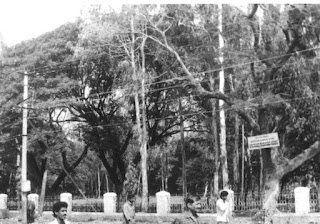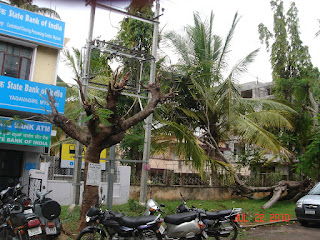The President's Cancer Panel, which consists of distinguished scientists and physicians, reports to the President of the United States on the development and execution of the National Cancer Program of the USA. It's
latest report submitted in May, 2010 has recommended that a prevention-oriented approach
should replace the current reactionary approach which emphasizes treatment after cancer is detected. Since this would mean that cancer detection and treatment would lose hundreds of billion dollars in funding, the report of the PCP has evoked sharp reactions from the cancer detection and treatment community.
Even after two hundred billion dollars (or Rs. 9 lakh crores!) have been spent over the last few decades to wage a "war on cancer" (the National Cancer Institute of the USA, by itself, has spent more than $105 billion) featuring intense and costly treatments, the actual survival rates have increased only marginally. The death rate for cancer (adjusted for age) dropped only 5% in fifty five years 1950-2005. If reduction in smoking and adoption of healthier life-styles are factored in, even this small reduction in the death rate may disappear or even become negative (In comparison, death rate for heart disease dropped 64% in this period, and that for flu and pneumonia fell by 58%). This means that despite innumerable new cancer drugs and new cancer treatments, cancer survival rate has not increased in the last 55 years.
Some rare cancers such as myeloid leukemia can be held in check by the drugs now available. But with most common forms (and many rare forms) of cancer, the outlook is not that good. If there is metastasis (i.e., the disease moves from one part of the body to another), the 5-year survival rates are 30% (prostate cancer), 20% (breast cancer), 10% (colo-rectal cancer) and less than 10% (lung cancer). These numbers have not changed in the last several decades.
The statistics quoted above are from
New York Times of 23-4-09 . New York Times is one of the leading newspapers of the world known for its sober in-depth reporting and is not given to fear-mongering or sensationalizing. It seems that such undeniably discouraging statistics made the President's Cancer Panel acknowledge for the first time in its 13 year history that the war on cancer is not being won despite astronomical spending and therefore recommend that the focus should be shifted from curing cancer to preventing cancer.
Despite these startling facts, it is surprising that most doctors and ordinary people feel that cancer can be cured. It seems that most experts and the media are glossing over these numbers and presenting only the positives of cancer treatment. Except for some forms of cancer (childhood cancers and testicular cancer), there is no cure once the cancer has spread. It can only be kept in check and that too for a limited period. When a treatment offers a "significant survival advantage", this advantage could only be a few more weeks or even days. These facts are again from the New York Times article.
The PCP report points out several major shortcomings in current cancer research. Some of them are:
1. When cancer risk from radiation exposure is estimated, it is based on the impact on a "Reference Man" - a hypothetical male, 5'7" tall, weighing 157 pounds, and who is Western European. It will definitely not apply to most men on earth and certainly not to women. So what is safe for the Reference Man may not be safe for the vast majority of people on this planet. Radiation doses in cancer treatment are also based on the "Reference Man" and so are inappropriate for the vast majority of people.
2. People who receive multiple CT scans or other tests that require radiation may be getting more radiation than Hiroshima atomic bomb survivors. Radiation is a proven cause of cancer. Since prescription of scans is increasing exponentially, a significant portion of the public are at risk of increased incidence of cancer.
3. When cancer risk from chemicals are estimated, chemicals are studied only one at a time. The combined effect of more than one chemical (it may be much higher than the sum of the effects) or the long-term effects from multiple exposures are not considered.
There are some other myths related to cancer such as:
*Surgery is believed to be a cure for cancer, especially cancerous tumours. But there is evidence that surgery can promote migration of cancer cells to other parts of the body and actually worsen the patient's condition. This has been discussed in a National Center for Biotechnology Information
publication . It appears that there are inherent immunological mechanisms in the body which inhibit migration of cancer cells from tumours, but surgery suppresses these mechanisms. As a result, many cancer patients who may survive for long without surgery may die soon after surgery.
*Screening for cancer is being promoted with the belief that if cancer is detected early, it can be nipped in the bud. An article in the 20-10-09
issue of New York Times indicates that this may not always be the case. It appears that there are thousands of cancer cells in everyone, but in the vast majority of the population, none of these cells, if left alone, will start multiplying and pose a threat to life. Only in a very small percentage of people will the cells multiply and pose a danger. Increased scanning detects increased cancer cells, but most of them are innocuous. But these cases are given cancer treatment when there is no need for treatment at all. This is a clear case of over diagnosis. But most doctors still find it hard to believe that many cancers are not dangerous and might actually go away on their own. According to Dr. Peter Albertsen, chief and program director of the urology division at the University of Connecticut Health Center, "Politically, it's almost unacceptable".
But facts are hard to ignore forever. The American Cancer Society, which has always been a staunch defender of cancer screening, has finally admitted in
its website that the benefits of detecting many cancers, especially breast and prostate, have been overstated. According to Dr. Otis Brawley, chief medical officer of the cancer society, "I'm admitting that American medicine has over promised when it comes to screening. The advantages to screening have been exaggerated."
C.V. Nagaraj, Mysore Grahakara Parishat



